
S. Hripsimeh, photo Karen_T, Panoramio
A History of Romanesque Architecture
Pre-Romanesque
Architecture
600-1000 AD
In trying to piece together this architecturally rich period I will deviate from my historical sequence and group stylistically similar buildings together.
The East I
Armenia and Georgia, 7th–10th century
Armenia adopted Christianity as a state religion in the early 4th century – before Constantin I. Armenians, being excellent architects, developed their own style and built a great number of churches in today’s Armenia, Georgia, and Turkey. They are generally mentioned only as marginal notes in western architectural treatises. The surviving buildings are too many to do them justice here. The apogee of Armenian architecture falls into the 7th to 9th century.
Armenia, Echmiadzin, Church of S.
Hripsimeh
615-628

S.
Hripsimeh, photo Karen_T,
Panoramio
The church was erected by the Katholikos Komitas (615-628). The present church was erected over a 4th century mausoleum built by Katolikos Sahak. During the renovations of 1959-1962, the remains of a pagan structure were found beneath the floor of the church.
Armenia, Zvartnots Cathedral
648
- 652
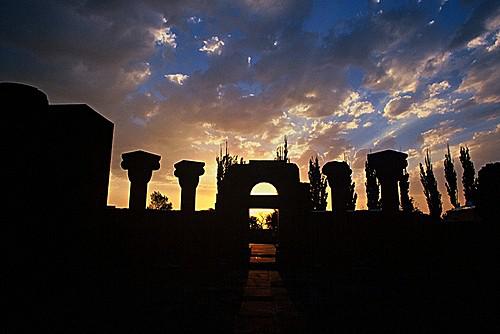
Ruins
of Zvartnots Cathedral, photo Ardani,
Panoramio
Between
643 and 652 Catholikos Nerses III, the Builder built a majestic
cathedral dedicated to St. George at the place where a meeting
between King Trdat III and Gregory the Illuminator was supposed to
have taken place. In 930 the church was ruined by an earthquake, and
remained buried until its rediscovery in the early 20th
century.
Wikipedia
Turkey, Tao-Klarjeti, 7th-10th cent
Tao-Klarjeti
(Georgian: ტაო–კლარჯეთი;
t'ao-k'larjeti) is the term conventionally used in modern history
writing to describe the historic south-western Georgian kingdoms and
principalities (7th-11th cent), now forming part of north-eastern
Turkey divided among the provinces of Erzurum, Artvin, Ardahan and
Kars. A number of churches, many in deplorable condition, have
survived in the area, which, following the Otoman conquest in 1551,
became Moslem. Best known are the monasteries of Bana (Turk. Penek),
Khandzta, Khakhuli,
Ancha, (Turk. Haho/Bağbaşi), the churches of Oshki (Turk. Öşk
Vank/Çamlıyamaç), Ishkhani (Turk. Işhan), Parkhali (Turk.
Barhal/Altıparmak), Doliskana
(Turk. Dolişhane/ Hamamlıköy), Otkhta
Eklesia (Turk. Dörtkilise), Opiza
(Turk. Bağcılar), Parekhi and Tbeti (Turk. Cevizli).
For a
definitive, scholarly review of the chuches of Tao-Klarjeti get
Wachtang
Djobadze's book from the library.
Turkey, Tao-Klarjeti, Bana Cathedral 630
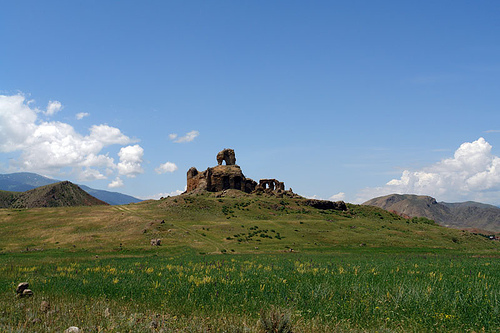
The
ruins of Bana Cathedral in Tao-Klarjeti, photo Paata Vardanashvili
Wikipedia
The Cathedral of Bana (630) is one of the earliest. The unique circular monument, reminiscent of Svartnots (Armenia) and St. Gregory-Ani (Turkey), has been subjected to extensive quarring of stones and spolia. It is today one of the most endangered archeological sites in northeastern Turkey.
Turkey, Cappadocia, 6 th-13 th cent
Cappadocia (from Greek: Καππαδοκία / Kappadokía) is a historical region in Central Anatolia, Turkey.
Herodotus reported that the Cappadocians occupied the whole region from Mount Taurus to the vicinity of the Euxine (Black) Sea. The name was traditionally used in Christian sources throughout history and is still widely applied to the peculiar geology and the unique historical and cultural heritage of the area.
In the Middle Ages Cappadocia was
inhabited by Greek-speaking, Christian Orthodox people who carved
entire underground cities and Byzantine cave churches out of the
volcanic formations and decorated them with painted icons, Greek
writing, and decorations. Over 700 of these Churches have been
discovered dating from the period between the 6th century to the 13th
century. Many of these monasteries and churches continued to be used
until the population exchange between Greece and Turkey in the
1920s.
Wikpedia
Turkey, Cappadocia, Ihlara Valley,
Frescoes in the Greek Cave Churches of Peristrema
8th cent.
|
|
|
There are supposedly twenty-five chapels and churches hidden in caves in the rock walls. After a snowstorm on the first of May, we could find only three, but they were special. The paintings in the Sümbüllü Kilise - the Church of the Hyacinth are in particularly good condition.
This "Elevation of Christ" predates the Iconoclast Period — i.e., it goes back to the beginning of the 8th century. It differs from the Elevation (a relief not a fresco) at Djvari-Mtskheta in Georgia (6th cent) where Christ is represented only by a cross carried by angels. Christ now appears, floating on a Greek cross, and carried (according to the Peudo-Dionysos Arapagitos' neoplatonic visions, ~ 532) by tweny-four wonderfully naïve angels.
The frescoes in the vault of the Church Beneath a Tree (Ağaçaltı
Kilise), are a century later! Fully abstract - an influence of the
nascent Islamic movement with its prohibition of images - they date
to the Iconoclast Period (725-843 AD).
Photos RWFG
Georgia, 7th-13th century
Georgia was Christianized in the 6th century and, excepting Georgian Tao-Klarjeti was not overrun by Islam until the 14th century. Its Christian architecture reached its highest development under Queen Tamara Bragationi in the 12th-13th century.
Georgia, Church of Ateni Sioni, 7th-8th cent

The
church in its mountain setting, photo RWFG
Ateni Sioni Church (Georgian: ატენის სიონი) is an 8th-century Georgian Orthodox church in the village of Ateni, some 10 km south of the city of Gori, Georgia. It stands in a setting of the Tana River valley known not only for its historical monuments but also for its picturesque landscapes. The name "Sioni" derives from Mount Zion at Jerusalem.
Ateni's 12th-century frescoes are one of the treasures of Georgia. The Djvari-type church probably dates from the 8th cent, as the recent discovery of iconoclast (725-843 AD) frescoes has shown. Ateni's frescoes differ from contemporary murals in the Greek-Byzantine churches by their liveliness. Joseph's dream may be the most celebrated of them:
England
and Ireland
7th-10th century
Anglo-Saxon architecture was a period in the history of architecture in England, and parts of Wales, from the mid-5th century until the Norman Conquest of 1066. Anglo-Saxon secular buildings in Britain were generally simple, constructed mainly using timber with thatch for roofing. No universally accepted example survives above ground.
There are, however, many remains of Anglo-Saxon church architecture. At least fifty churches are of Anglo-Saxon origin with major Anglo-Saxon architectural features, with many more claiming to be, although in some cases the Anglo-Saxon part is small and much-altered. All surviving churches, except one timber church, are built of stone or brick, and in some cases show evidence of re-used Roman spolia.
The architectural character of
Anglo-Saxon ecclesiastical buildings range from Celtic influenced
architecture in the early period; Early Christian basilica influenced
architecture; and in the later Anglo-Saxon period, an architecture
characterised by pilaster-strips, blank arcading, baluster shafts and
triangular headed openings. In the last decades of the Anglo-Saxon
kingdom a more general Romanesque style was introduced from the
Continent,
Wikipedia
England, Winchester Anglo-Saxon
Minster
648-1093
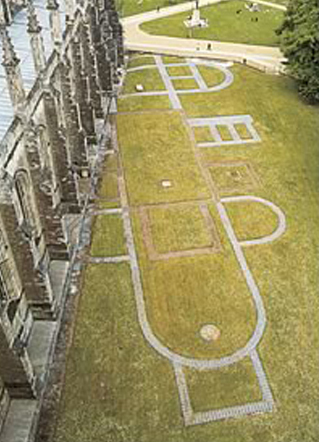
The
foundations of the Old Winchester Cathedral next to its succesor are
visible from outer space
photo freepages
The Old Minster was the Anglo-Saxon cathedral for the diocese of
Wessex and then Winchester from 660 to 1093. It stood on a site
immediately north of and partially beneath its successor, Winchester
Cathedral.
The old legend that the Old Minster was built in the
2nd century for the non-ducumented King Lucius of Britain is
erroneous. The stone minster was constructed in 648 for King Cenwalh
of Wessex and Saint Birinus. It became the diocesan cathedral in 660.
It was enlarged and redecorated over the years and Saint Swithun was
buried outside it in 862. In 901, the New Minster was built next to
it, so close in fact that it is said the singing of the monks inside
each became hopelessly intermingled. Saint Æthelwold of Winchester
followed by his successor, Saint Alphege, almost completely rebuilt
the minster on a vast scale during their monastic reforms of the
970s. Saint Swithun's body was taken into an indoor shrine in what
had become the largest church in Europe. However, after the Norman
conquest of England, Bishop Walkelin built a replacement cathedral
alongside and the Old Minster was demolished in 1093. Many of the
Kings of Wessex and England, as well as holy saints, had been buried
there, so their bodies were dug up and re-interred in the new
building. The Old Minster was excavated in the 1960s.
Wikipedia
Ireland, Gallarus Oratory, Dingle
Peninsula
7th- 8th cent
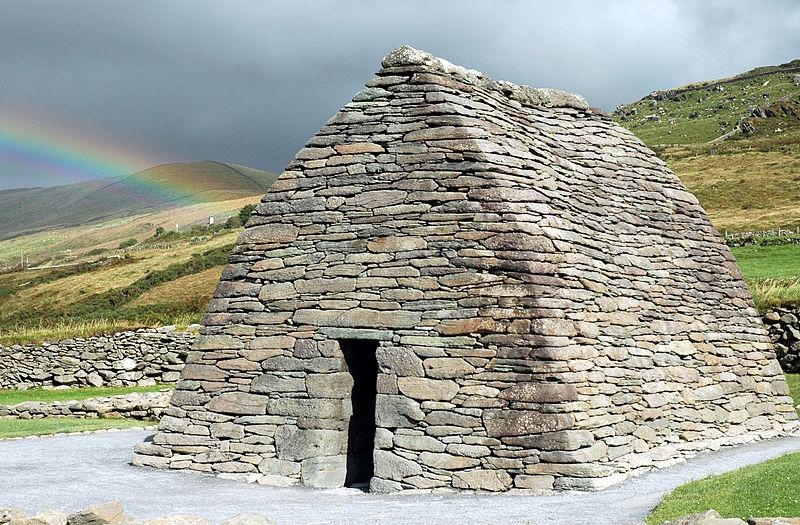
The
Oratory, photo
Wikipedia
Gallarus Oratory was built between the seventh and eight century and is the best preserved early Christian church in Ireland. It represents the apogee of dry-stone corbelling, using techniques first developed by Neolithic tomb-makers.
Ireland, Monastery of Kells
804
|
|
|
The Abbey of Kells was first founded by St. Columba ca. 554. What some historians term a refounding happened in the early ninth century by Columban monks fleeing from Iona which was repeatedly raided by Vikings. The site was a former Irish hill fort. In 814, Cellach, Abbot of Iona, retired to Kells. The monastery is famous for it's Round Tower and Celtic High Crosses.
The Book of Kells was written here in the 9th century. The title page
of St. Mathew's Gospel in the Book of Kells shown above, is presumed
to be from around 800. The elaborate ornamental "carpet"
design was influenced by early Islamic examples, brought from Syria
by a monk, who became shipwrecked near Kells.
Photos Wikipedia
Visigoth
and Mozarab Spain
7th-9th century
For a general discussion see Wikipedia
Spain, San Martín de Montalbán,
Santa María de Melque
7th
cent
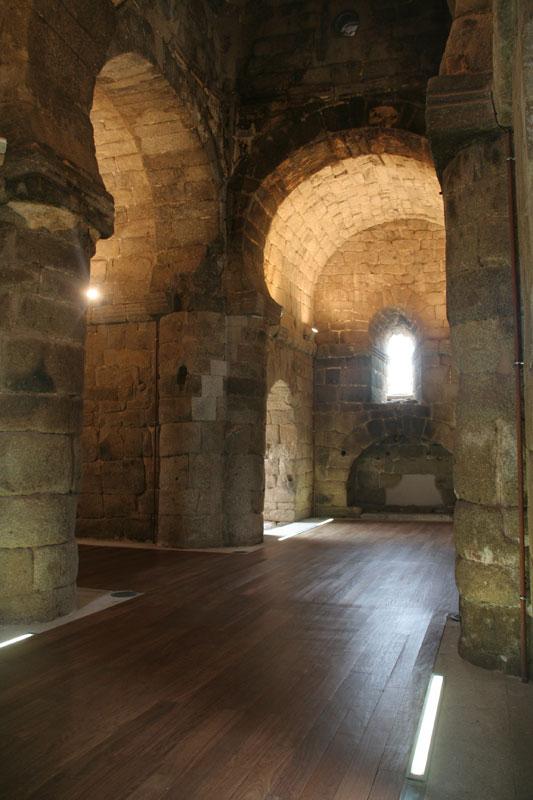
Interior
with Visigoth/Mozarab arches. Photo by
Shenkaros, Panoramio
The church stands out as exemplary Mozarabic-Visigoth architecture, the most important religious monument of the Early Middle Ages in Spain.
Santa María de Melque came into being as a monastic complex in the
7th and 8th centuries inside of what was the capital of the
Visigothic Kingdom, Toledo. Construction commenced in the 7th
century, coinciding with the end of the Visigothic kingdom, and
probably came to a halt with the arrival of the Arabs, only to be
continued later. Melque could have been at first a mausoleum,
destined as a burial place of a distinguished personage from Toledo's
Visigothic Kingdom. The church was later redesigned on at least two
occasions.
More: Wikipedia
Spain, Campillo, San Pedro de la
Nave
680
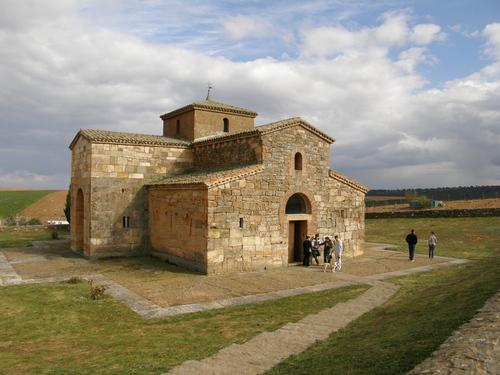
Photo by
vacceos, Panoramio
The church foundation goes back to the reign of Ergica, having been built between 680 and the Muslim conquest of Spain in 711; San Pedro de la Nave is thus another example of the last Visigothic church buildings.
Originally the church was sited on
the banks of the river Esla, but, when the Ricobayo dam was built, it
was moved to avoid submersion in the higher waters of the Esla.
Thanks to the efforts of Manuel Gómez-Moreno, it was decided that
the church would be moved stone by stone to its current location.
This operation was carried out in 1930-32, under the direction of the
architect Alejandro Ferrant Vázquez. - The church's first design
corresponded to a Greek cross in plan, although later two lateral
naves were added, which gave it a hybrid shape between basilical and
cruciform.
Wikipedia
Italy,
Lombard Architecture
Northern Italy: 568-774,
Southern Italy: 10th-11th centuries
The term Lombard architecture refers to the architecture of the Kingdom of the Lombards in Italy, which lasted from 568 to 774 (with residual permanence in southern Italy) and which was commissioned by Lombard kings and dukes.
When they arrived in Italy (Suebi) in the late 6th century, the Lombards had no architectural tradition of their own. They thus relied on local workforce, taking advantage of the presence of organizations and guilds capable of high level works, which had been kept alive thanks to the relative survival of the urban civilization in Italy after the fall of the Western Roman Empire (differently from most of contemporary Christian western Europe).
The architectural works of the Lombards in northern Italy
(Langobardia Maior) have been mostly lost due to later renovations or
reconstructions, the few exceptions including the Lombard Temple at
Cividale
del Friuli or the church of Santa
Maria fuori Portas at Castelseprio. More examples have survived
in southern Italy (Langobardia minor), especially in what was the
Duchy of Benevento: they include the city's walls, the church of
Santa Sofia and the Rocca dei Rettori, one of the few surviving
Lombard military structures, as well as other minor sites near
Benevento and in the former duchy of Spoleto.
Wikipedia
Italy, Benevento,
Lombard Church of Santa Sophia
770
In southern Italy (Langobardia minor), still partly under effective Lombard domination, architecture followed original lines until the conquest by the Normans in the 11th century. This unity is shown in particular by the most important Lombard edifice in what was Langobardia Minor, the church of Santa Sofia at Benevento: built in the 8th century, it follows the same pattern of Santa Maria in Pertica with an elevated central body, although mitigated by Byzantine elements such as the articulations of the volumes and the basic structure itself, perhaps inspired by Hagia Sofia at Constantinople
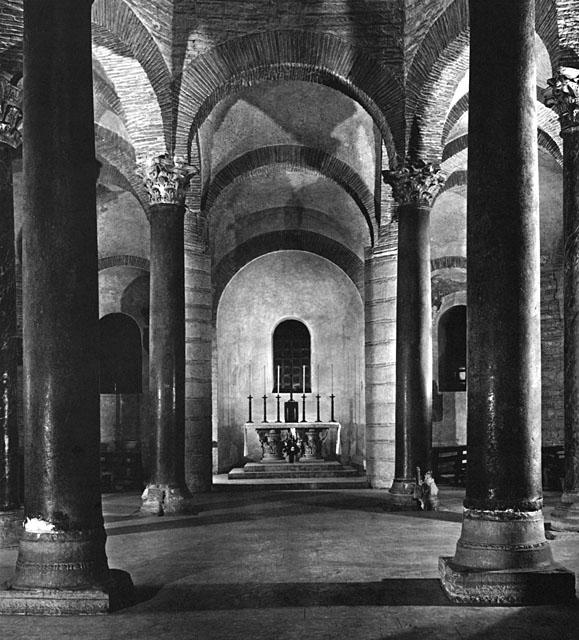
Interior
of the chiesa di Santa Sofia in Benevento, Lombardia.
Photo thais.it
The church was founded by the Lombard Arechis II of Benevento around 760, as testified by numerous privileges signed by him, some of which are in the Museum of Samnium near the church. The edifice was modeled on the Palatine Chapel of the Lombard king Liutprand in Pavia and, after the defeat of Desiderius by Charlemagne and the fall of the Lombard kingdom in northern Italy (774), it became the national church of the Lombards who had taken shelter in the Duchy of Benevento. The church was part of a large program of construction which would legitimate Arechis' claim as the principal Lombard authority, after his failed attempt to acquire the title of king and the renaming of the duchy as a principality.
Arechis dedicated it to St. Sophia, after the Haghia
Sophia basilica in Constantinople; he also annexed a Benedictine
female convent, a dependance of the Abbey of Montecassino and led by
his sister Gariperga. The sanctuary also housed the relics of Saint
Mercurius abandoned in 633 near Quintodecimo by the eastern Roman
emperor Constans II.
Wikipedia
Carolingian
Architecture
800-900
Carolingian architecture is a northern European Pre-Romanesque style belonging to the period of the Carolingian Renaissance of the late 8th and 9th centuries, when Charlemagne dominated western Europe politically. It was a conscious attempt to emulate Roman architecture and to that end it borrowed heavily from Early Christian and Byzantine architecture, though there are nonetheless innovations of its own, resulting in a unique character.
Most notable examples some of which will appear in chronological
order further on:
St. Gallen
Abbey, monastic complex (613, 8th-9th cent.)
Benedictine
Convent of Saint John, Val Müstair, Graubünden (780-9th
cent)
Lorsch Abbey, gateway, (c.800)
Palatine Chapel in Aachen
(Aix-la-Chapelle) (792-805)
St.
Ursmar's Collegiate church in Lobbes, Belgium (819-823)
St.
Michael, Fulda, rotunda and crypt (822)
Einhard's Basilica,
Steinbach (827)
Saint
Justinus' church, Frankfurt-Höchst (830)
Abbey of Corvey
(885)
St. George, Oberzell on Reichenau Island (888)
Switzerland, Monastery St. Gallen
613, 8th-9th cent, Baroque interior 17th cent
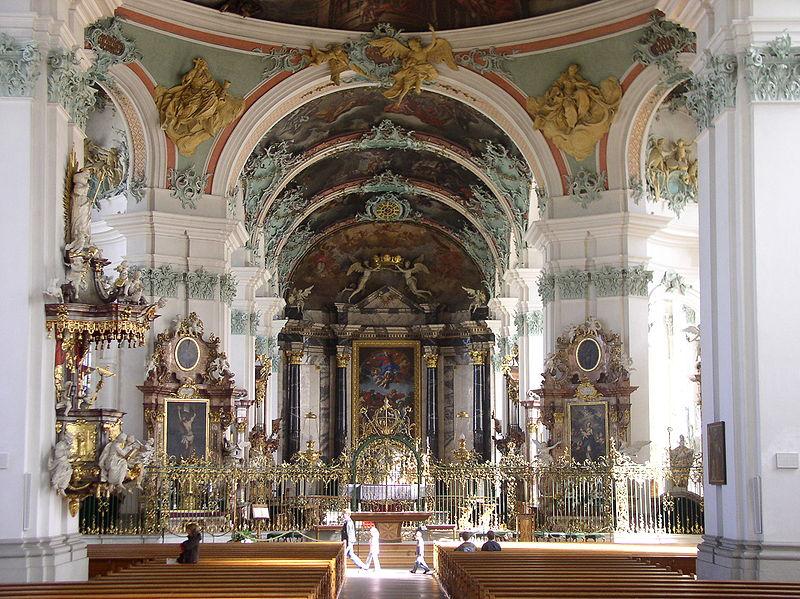
St
Gallen, the 17th-century Baroque interior,
Photos Wikipedia
The monastery was founded in 613 and named after Gallus, an Irishman. St.Gallen became one of the most important Carolingian study centeres. In 740 St. Gall's famous library was estanlished. Numerous Anglo-Saxon and Irish monks came to copy manuscripts. At Charlemagne's request Pope Adrian I sent distinguished chanters from Rome, who propagated the use of the Gregorian chant. Today the library at the Abbey is considered one of the richest medieval libraries in the world.

Plan
of the early Carolingian abbey 816-830
A floor plan of the original Carolingian Benedictine abbey is preserved. During the late 17th cent the 9th cent church was replaced by an early Baroque wonder.
Germany, Lorsch, Carolingian
Benedictine Abbey
764

The
Königshalle, 9th cent, photo thaïs.it
The Abbey of Lorsch is a former Imperial Abbey in Lorsch, Germany, about 10 km east of Worms, one of the most renowned monasteries of the Carolingian Empire. Even in its ruined state, its remains are among the most important pre-Romanesque–Carolingian style buildings in Germany.
The abbey was founded in 764 by the Frankish Count Cancor and his widowed mother Williswinda as a proprietary church (Eigenkirche) and monastery on their estate, Laurissa.
The “Königshalle”,the entrance hall, (illustrated
above), built in the ninth century by Emperor Louis III (880-928) is
one of the most beautiful monuments of Carolingian
architecture.
Wikepedia
Germany, Aachen, Aix-en-Chapelle,
Imperial Capella Palatina
792-805, 1414
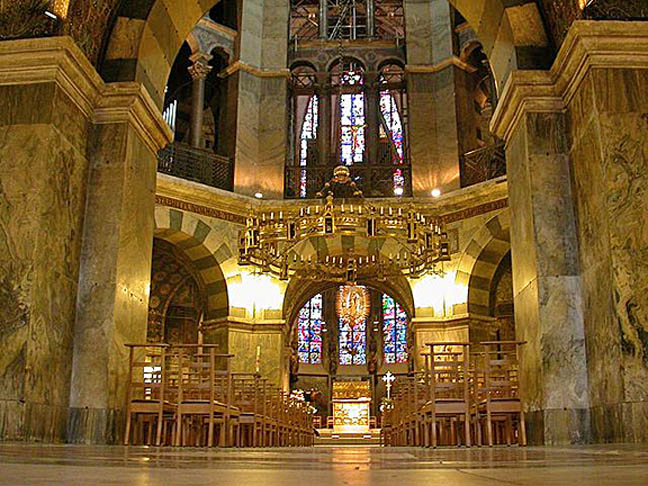
The
Carolingian Octagon with the later Gothic choir in the
background
photo Wikipedia
Charles the Great (Charlemagne) began the construction of the Palatine Chapel around 792, along with the construction of the imperial palace structures. It was consecrated in 805 by Pope Leo III in honour of the Virgin Mary. Extensively renovated in the 10th century it was restored in 1881. The core, the octagonal center of the cathedral was the Carolingian Palatine Chapel. It is reminicent of San Vitale in Ravenna.

Floorplan
of the Chapel with later additions
In order to sustain the enormous flow of pilgrims in the Gothic period a choir was added: a two-part Capella vitrea (glass chapel) which was consecrated 1414 on the 600th anniversary of Charlemagne's death.
Aachen Cathedral, the "Imperial Cathedral" (Kaiserdom), is
the prime monument of the Carolingian period. It was known as the
"Royal Church of St. Mary at Aachen" during the Middle
Ages. For 600 years, from 936 to 1531, the Aachen chapel was the
church of coronation for 30 German kings and 12 queens.
Text and
plan Wikipedia
France, St. Germiny-des-Pres,
l'Oratoire
806
The small, plain church incorporates at its east end one of the few surviving buildings from the Carolingian Renaissance, a tiny, perfectly formed church in the shape of a Greek cross. It was built in 806 as a private oratory for Theodulf, who was one of Charlemagne's counselors as well as bishop of Orléans and abbot of St-Benoît. Theodulf was a Visigoth, while the chapel itself is a typically Carolingian design, its unique mosaic in the dome of the eastern chapel points to Byzantine influences – at the height of the Iconoclast controversy!.
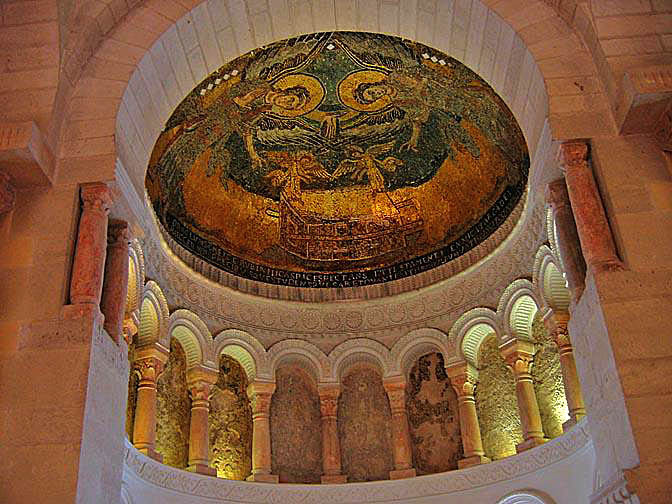
The
mosaic in Theodulf's private Oratory,
Photo JMZ-2007,
Panoramio
JMZ, who lives near St. Germiny-de-Pres, wites in a private communication: "The writing in silver letters under the mosaïc says in Latin: 'Behold the Holy Oracle and Cherubims and contemplate the shining Arc of the Covenant with God. Then, seeing this, I beg you to join the name of Theodulf to your prayers to the Master of Thunder.' - The origin of this motive is not clear and we lack written evidence. Archeological findings of fragments of other mosaics nearby suggest that the decorative program of this chapel was related to the Temple of king Solomon. Theodulf was of Wisigothic descent. He may have had more likely links with Mozarabic artists or Sefardic Jews of the Ummayad 'Al-Andalus' emirate of Cordoba in Spain than with the remote Byzantine East, but that's simply a supposition of mine."
The uniqueness of this mosaic lies in its subject: the Old Testament
Ark of the Jewish Covenant (Josh. 3:6; Hebrews 9:4) ! - even the two
angels were included in the composition. - does not seem to exist
anywhere else - obviously not in Jewish synagogues neither in
Christian churches. Yet JMZ's suggestion of a connection to
Al-Andalus is not without reason:
Theodulf was born into an
aristocratic family around 750 in Visigothic Spain, but fled north as
a young man during the Moorish invasions. He became one of
Charlemagne's most trusted counselors and a major figure in the
Carolingian royal court.
Sacred
Destinations
Germany, Fulda, St.
Michael
820-822
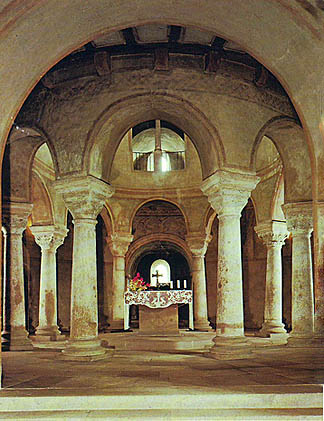
The
octagonal center of the church, photo
flickr
Octagonal St. Michael Church in Fulda was built in the Carolingian style (Pre-Romanesque) on behalf of abbot Eigil in the years 820 - 822. It served as a burial chapel to Fulda monastery founded in 744, which was one of the prominent cultural centres of the early Middle Ages. The architect was probably the monk Racholf (d. 824). The rotunda and crypt remain preserved from this time.
Germany, Corvey Benedictine
Monastery
822
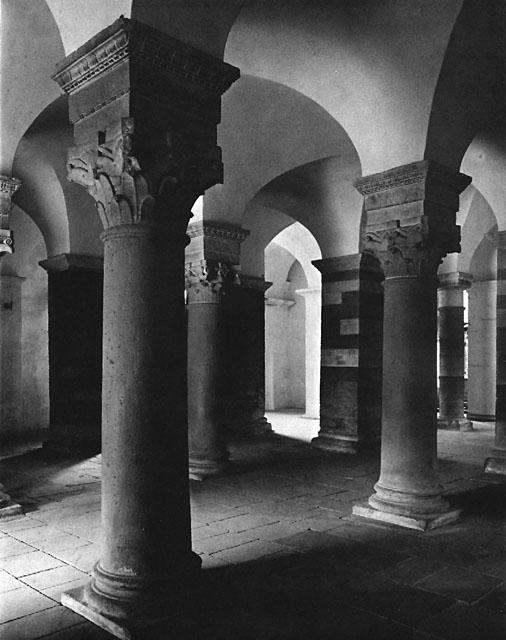
Crypt
of the Corvey Benedictine Abbey Church 822 – 844
Photo
thais.it/architettura/romanica/
Corvey Abbey was first founded in 815 among the recently converted Saxons on a site called Hethis by Charlemagne's cousins Wala and Adelard, with monks from Corbie Abbey in Picardy. Under the joint patronage of Emperor Louis the Pious and the abbot of the older foundation, whence the new one derived its name (Latin: Corbeia nova, the "new Corbie").
In 822 the monastery was reconstructed on the present site near the
banks of the river Weser. It became "one of the most privileged
Carolingian monastic establishments in the ninth-century Duchy of
Saxony". A mint was authorized as early as 833 though surviving
coins date from the early eleventh century. The site of the abbey,
where the east-west route called the Hellweg crossed the Weser,
accounted for some strategic importance and assured its economic and
cultural importance. The abbey's historian H. H. Kaminsky estimates
that the royal entourage visited Corvey at least 110 times before
1073, occasions for the issuance of charters.
Wikipedia
Germany Steinbach, Einhard's
Basilica
824-827

"Einhard's
Basilica" in Steinbach 824-827
The Einhardsbasilika in Steinbach, a suburb of Michelstadt in the
Hessian Odenwald, is a church from the 9th Century. The
well-preserved basilica is considered an extraordinary building. Its
largely preserved Carolingian masonry in the nave, chancel and the
north side of the crypt, makes it one of the best examples of
Carolingian architecture in Germany. Its name refers to its builder
Einhard, the biographer of Charlemagne and counsellor of Louis the
Pious
Restored to its original condition 2006-2010
Wikipedia.de
in German
Germany, Frankfurt-Höchst, St.
Justinius
~ 830
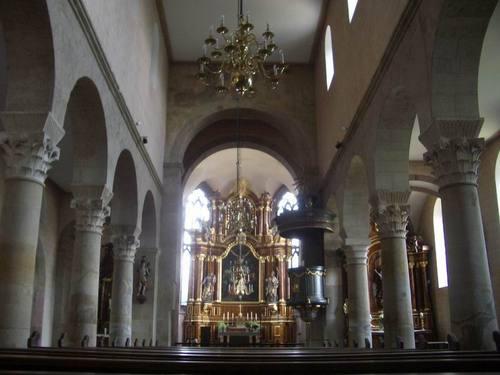
The
Carolingian nave (~830) and the Baroque altar (18th cent).
Photo
Michael
König, Panoramio
The original church was a six-bay basilica with three apses at the east end. The entrance was originally at the west end of the central nave, but is now on the north side of the church. The aisle windows have been replaced, and late gothic chapels were added on the north side. Also the side apses were removed following the alterations.
Of the Carolingian work that has survived are the central nave with small clerestory windows, the flat ceiling, the aisles, and the two sets of five columns with Corinthian capitals, which belong to the most important works of Carolingian art
Germany Reichenau Oberzell, St.
Georg
890-896
The Reichenau is an island in Lake Constance. During the 8th century a monastic center was establiched in Mittelzell, which became a powerhouse of European art and scholarship, especially in painting. In the 9 th-10 th cent. three churches were built at Oberzell, Mittelzell, and Niederzell, of which St. George in Oberzell is the oldest. All three have been restored during the last 80 years.
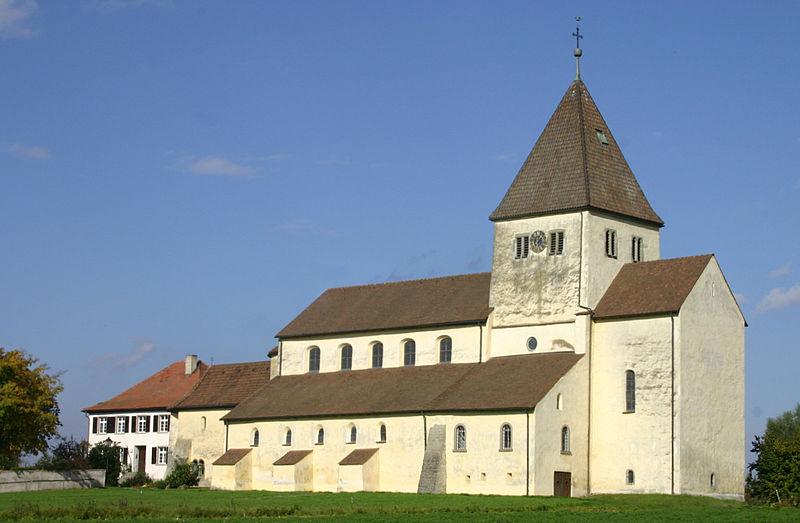
The
church at Oberzell
Late Carolingian St. Georg is the earliest of
the three churches on Reichenau Island, with rich Romansque frescoes
from the 10th cen

Frescoes
in the nave: Scenes from the Life of Christ, 10th
cent.
Photo by
ochmann
France, Abbaye de Cluny, 910
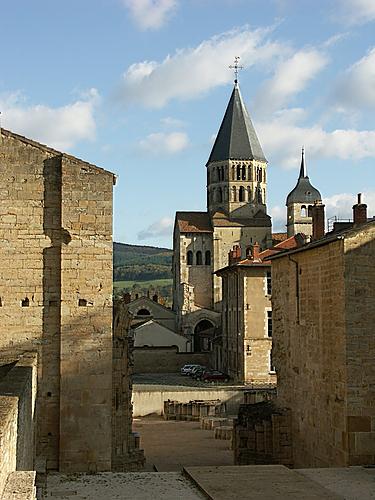
Photo by
yves_grau, Panoramio
The Abbaye de Cluny was founded in 910 by William I, Count of the Auvergne, who installed Abbot Berno and placed the abbey under the immediate authority of Pope Sergius III.
The Benedictine Order was a keystone to the stability that European
society achieved in the 11th century, and partly owing to the
stricter adherence to a reformed Benedictine rule, Cluny became the
acknowledged leader of western monasticism from the later 10th
century on. A sequence of highly competent abbots of Cluny were
statesmen on an international stage. The monastery of Cluny itself
became the grandest, most prestigious, and best endowed monastic
institution in Europe. The height of Cluniac influence was from the
second half of the 10th century through the early 12th. The Abbey was
sacked and mostly destroyed in 1790 by a mob of French
revolutionaries. Only a small part of the original remains.
Wikipedia
Ottonian Architecture
Germany, Cologne, St. Pantaleon
Ottonian, 970-980
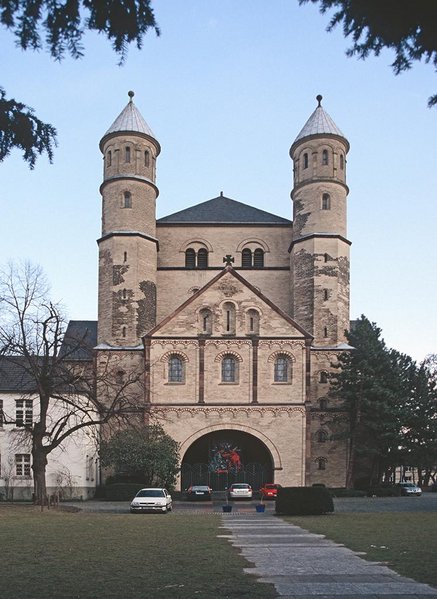
West
façade of St. Pantaleon (972), photo Wikipedia
The Church of St. Pantaleon dates back to the 10th century and is one the twelve Romanesque churches of Cologne. The former monastery church iwas consecrated to Saint Pantaleon and the Saints Cosmas and Damian and is the oldest church of the cult of Saint Pantaleon west of Byzantium.
A Roman villa originally occupied the hill, just outside Roman Cologne, on which the church stands. Remains of this villa are still visible in the church crypt. The villa was replaced with a church around 870, and in 955 Archbishop Bruno the Great (brother of Emperor Otto the Great) added a Benedictine abbey. Here, Bruno was buried after his death. In 966 work was begun on a new church to serve the monastery. The church was consecrated in 980.
Holy Roman Empress Theophano, a Byzantine princess who was married to
Emperor Otto II in 972, ordered the construction of the current
façade and was also buried in the church at her own request.
Text
and photo Wikipedia
Spain,
Asturias
Oviedo,
9 th cent.
The palaces and churches in the
surroundings of Oviedo provide eminent testimony to the civilization
of the small Christian Kingdom of Asturias during the splendour of
the Emirate of Cordoba. Pre-Romanesque Asturian architecture
represents a unique artistic achievement which is neither a
metamorphosis of palaeo-Christian art nor a feature of Carolingian
art. These churches, which are basilical in layout and entirely
vaulted, and which make use of columns instead of piers, have very
rich decors which contain Visigothic references, Arabic elements, and
shapes that associate them with the great sanctuaries of Asia Minor.
Asturian monuments have exerted a decisive influence on the
development of medieval architecture on the Iberian peninsula.
UNESCO
Citation
Oviedo San Julian de los Prados 812 -842

Photo
vcespon,
Panoramio
The church is not the oldest but perhaps the most interesting of the 4 early Romanesque churches in Oviedo. It has a basilican plan with a nave and two aisles separated by square piers which support semi-circular arches and with a transept of impressive height. An iconostasis separates the sanctuary from the rest of the church. The size and originality of the church stands out and distinguishes it from other works of Visigothic art.

Most interesting are its aniconic frescoes – Spanish Iconoclast designs - painted in three layers, architectural decorations that like the iconostasis reflect Eastern Roman influences.
.Oviedo, Santa Maria del Naranco 842
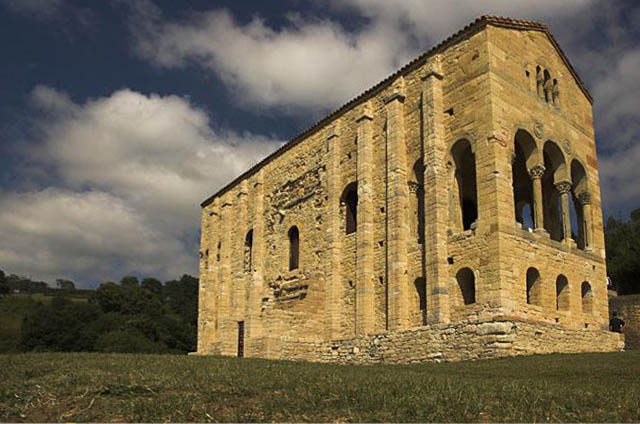
Photo wikipedia
The building was ordered by Ramiro I built as a palace, being finished in the year 842 AD, as part of a building complex that also included the nearby church of San Miguel de Lillo, erected just a hundred meters away. It was consecrated as a church in the 13th cent
Oviedo,.San Miguel de Lillo 842-848
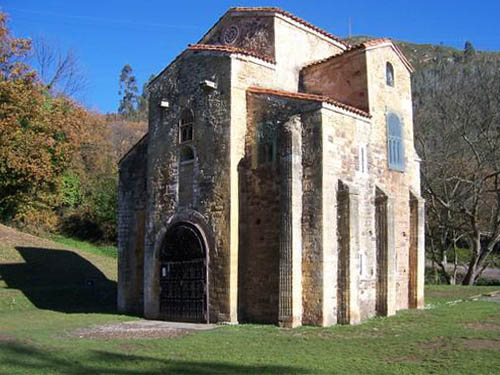
Photo margoban,
Panoramio
The two religious establishments on the southern side of the Naranco, Santa María del Naranco and San Miguel, were built during the harsh reign of Ramiro I (842-50). It is not known why he chose to locate these some miles outside the capital of his predecessor. The contribution of Alfonso III, last and greatest of the Asturian kings (866-910), was the construction of a fortress to the north-east, outside the walls. Below the castle, in a quarter known from its location as Socastiello, was the Jewish quarter in late medieval times.
On the death of Alfonso, the Royal court moved to León and Oviedo lost its important royal connections. However, it continued to hold a high place in religious and ecclesiastical affairs, rivalling Santiago de Compostela as a place of pilgrimage. It also attracted a number of Frankish immigrants, to such an extent that two separate jurisdictions were set up, one for the Castilian and the other for the Frankish part of the population. This connection with south-western France continued throughout the Middle Ages (see St. Germiny-de-Pres).
Mozarab
Northern Spain,
10th century
The Mozarabs were Iberian Christians who lived under Arab Islamic rule in Al-Andalus. Their descendants remained unconverted to Islam, but did adopt elements of Arabic language and culture. They were mostly Roman Catholics of the Visigothic or Mozarabic Rite.
Most of the Mozarabs were
descendants of Hispano–Gothic Christians and were primarily
speakers of the Mozarabic language. Many were also what the arabist
Mikel de Epalza calls "Neo-Mozarabs", that is Northern
Europeans who had come to the Iberian Peninsula and picked up Arabic,
thereby entering the Mozarabic community.
Wikipedia
Spain, Escalada, San Miguel
913

Photo
thais.it/architettura/romanica/
Following a period of Arab sovereignty, the Asturian King, Alfonso III conquered the region of Leon. The Mozarabic church at San Miguel de Escalada was commissioned in 913 under the rule of Alfonso's son, Garcia. This brick and masonry church features a basilica plan with its central nave partitioned from the two side aisles and the apse by colonnades of horseshoe arches. The Asturian Corinthian capitals and possibly Roman or Visigothic columns may already have been in situ.
Spain, Jaca,
Monastery San Juan de la Peña
920
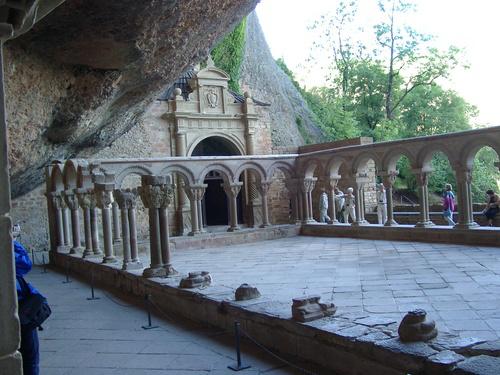
The
ruined cloisters. Photo by
Gerhard Tinhof, Panoramio
The monastery of San Juan de la Peña was one of the most important monasteries in Aragon in the Middle Ages. Its two-level church is partially carved in the stone of the great cliff that overhangs the foundation. San Juan de la Peña means "Saint John of the Cliff".
The lower church includes surviving mozarabic architectural elements, although most of the parts of the monastery (including the impressive cloister, under the great rock) are Romanesque. After a fire in 1675, a new monastery was built. The old monastery (920) was declared a National Monument on 13 July 1889, and the new monastery in 1923. In the 11th century the monastery became part of the Benedictine Order and was the first monastery in Spain to use the Latin Mass.
The cloister, built ca. 1190, contains a series of
capitals with Biblical scenes that originally were arranged in
chronological sequence, a design found elsewhere in the
region.
Wikipedia
Spain, San Cebrián de Mazote
Mozarab before 915

Interior,
photo forociudad.com
The church near Valladolid, impeccably restored 1932-34, is one of the most beautiful examples of Mozarab architecture in Northern Spain. Built during the Reconquista before 915 by Christian refugees from El Andalus. It has three naves and, like in Santiago de Penalta, two opposing altar niches in the main nave. Teh naves are separted be Corinthian collumns with horsshoe arches.
Unfortunately all descriptions, e.g.Wikipedia, are in untranslatable Spanish. I attach a plan, which describes the building better than I could.
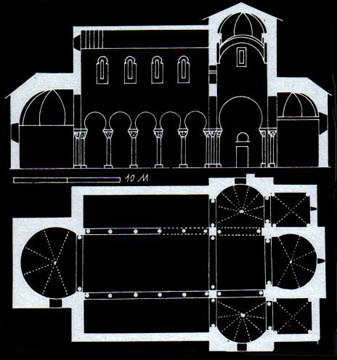
Plan
from jdiezarnal.com
Spain, Ponferrada, Santiago de
Peñalba
Mozarab 937
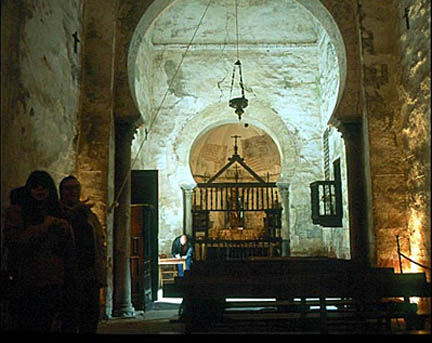
The
Mozarab horsshoe arch separting eastern from the western nave of the
church
The church of Santiago is the only remnant of a monastery founded by St. Gennadius in the tenth century (909-916), who retired there when he resigned the bishopric of Astorga. The church was built by his successor, Abbot Solomon in the year 937, to hold the remains of St. Gennadius.
The church was consecrated in 1105 and it as the tomb of St. Gennadius. He was buried in the western anti-apse of the church, but in the sixteenth century the Duchess of Alba carried his remains to Villafranca and later to Valladolid.
It is built on a Latin cross plan, consisting of a rectangular nave
with opposing apses and two side chapels or vestries, which
constitute a Latin cross. The nave is divided into two halves
separated by a large horseshoe arch on columns with Corinthian
capitals. The two naves have different elevation heights. It is
buttressed outside with large slabs slanted to drain water without
causing leaks. They serve the function of balancing the side chapels
and the naves of the church. The building measures 18 meters by 5
meters. The floor of the church is the original slate base.
Photo
and text jdiezarnal
Spain, Montbui, Santa Maria de la
Tossa
970

The
church of La Tossa, Montbui
The Pre-Romanesque church of the ninth and tenth centuries is one of the most interesting in Catalonia. It is a basilica and consists of three naves covered with barrel vaults, slightly horseshoe shaped and sustained by rectangular pillars in the western part of the church and cylindrical columns elsewhere. The sanctuary is closed by three semicircular apses, added later that contain Lombard arches outside. The condition is excellent.
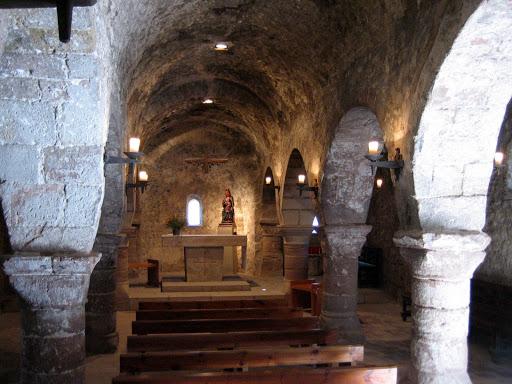
Interior
of the church. Photos castells,
picasaweb
The East II
Turkey,
Lake Van, Akhtamar, Church of the Holy Cross
920
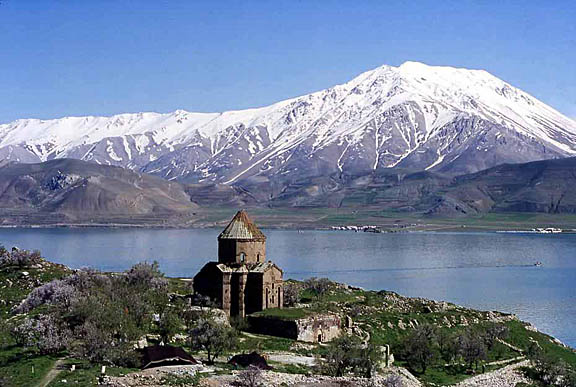
The
church on its island and the south shore of Lake Van
The Church of the Holy Cross on Akhtamar Island was a medieval cathedral of the Armenian Apostolic Church, built as a palatine church for the kings of Vaspurakan and later serving as the seat of the Armenian Catholicosate of Akhtamar.
The architecture of the church is based on a form that had been developed in Armenia several centuries earlier; the best-known example being that of the seventh century St. Hripsime church in Echmiadzin.
|
|
|
The unique are the extensive array of bas-relief carvings of mostly
biblical scenes that adorn its external walls.
Photos RWFG
Armenia,
Sanhin and Haghpat Monasteries
~970
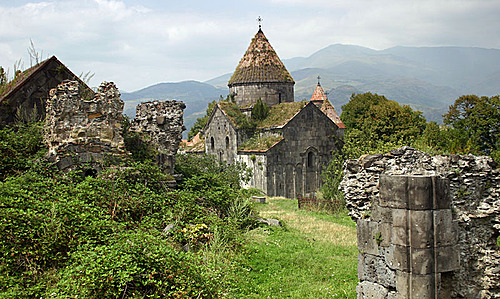
Sanahin
Monastery, Haghpat in the background, photo Panoramio
The monasteries are situated in the north of Armenia, in the Tumanian district. Sanahin is now within the limits of Alaverdi city, and Haghpat is to the north-east of it, in the village of the same name. Standing on a high plateau, amidst low structures, they rise sharp against the background of steep forest-grown slopes of Bazum ridge. The ensembles are complemented by small churches built near them.
The exact date of the foundation of Sanahin and Haghpat is unknown.
Documentary evidence and monuments of material culture suggest that
they date to the middle of the 10th century. The formation of the
Tashir-Dzoraget kingdom of the Kyurikids in 979 and the great
attention paid to Sanahin and Haghpat by various rulers of Armenia
and their vassals favored the construction of many religious and
civil structures there. In these monasteries, especially in Sanahin,
humanitarian sciences and medicine were studied, scientific treatises
written and paintings, most miniatures, created.
Armeniapedia
Turkey, Eastern Anatolia, Ruins of
Ani
10th-13th cent
Ani is a ruined and uninhabited medieval Armenian city-site situated in the Turkish province of Kars.
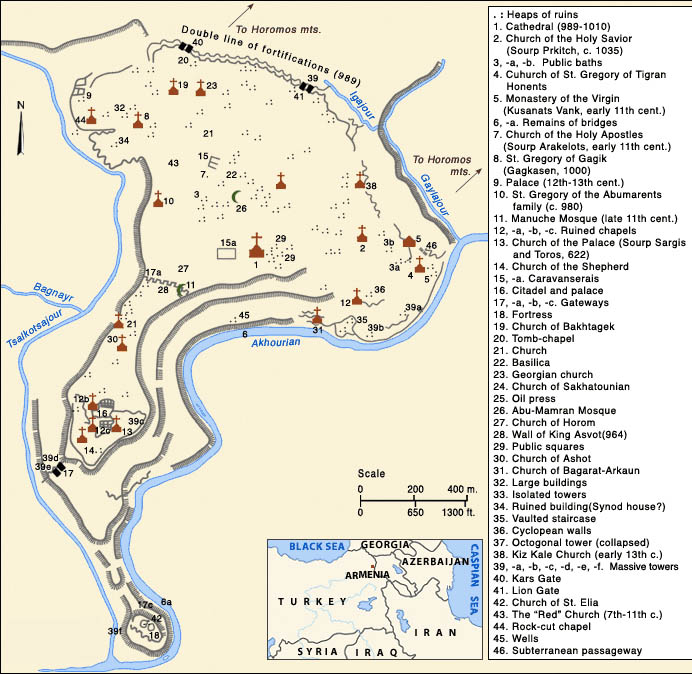
Plan
of Ani, Wikipedia
Ani was once a rich and important city on the Silk Road. Ani was first destroyed by the Selçuks in the 11th, a second time by Timur Tamerlane in the 13th century, finally an earthquake leveled it for good. In between it was for a while the capital of the Armenian kings, and the Armenians still consider "the City of a Hundred Churches" their holy shrine. Since the Russo-Turkish war of 1918 and especially in the 1960s it had been inaccessible to foreigners. For the first time in 1990 one could visit it on one's own without a military escort.
|
|
|
|
Largely unexcavated and badly neglected, there is not much to see. On
a triangular plateau between two rivers covered with rubble three
churches — easily identified by their careful masonry as Armenian —
are still standing.
More: Wikipedia